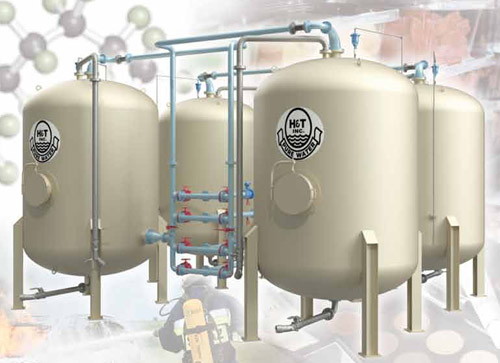Your Overview to PFAS Therapy Technologies and Conveniences
The prevalence of PFAS contamination in water resources requires a detailed understanding of offered treatment modern technologies. Each modern technology not only targets details PFAS substances yet also plays an important function in enhancing total water top quality and safeguarding ecological honesty.
Comprehending PFAS Contamination
Understanding PFAS contamination is important for resolving its pervasive effect on ecological and human health (m270 pfas treatment). Per- and polyfluoroalkyl substances (PFAS) are a group of synthetic chemicals extensively made use of in various commercial and consumer products because of their water- and grease-resistant buildings. Generally found in firefighting foams, non-stick cookware, and water-repellent materials, PFAS have actually gone into the setting with manufacturing processes, wastewater discharges, and seeping from garbage dumps
Once released, these materials continue in the atmosphere, leading to widespread contamination of soil and water sources. Their one-of-a-kind chemical structure, defined by strong carbon-fluorine bonds, renders them immune to degradation, resulting in a phenomenon referred to as "permanently chemicals." PFAS can accumulate in the human body and the food chain, possibly causing unfavorable health impacts, consisting of immune system disturbance, developing problems, and an increased danger of specific cancers cells.
Governing companies and health and wellness companies are increasingly acknowledging the relevance of PFAS contamination, prompting efforts to monitor, assess, and alleviate its impacts. Comprehending the paths of PFAS contamination is crucial for informing public law and creating efficient methods to safeguard both ecological and human health.
Overview of Treatment Technologies
Different treatment innovations have actually been developed to deal with the obstacles postured by PFAS contamination in water and dirt. These modern technologies can be generally categorized into numerous groups, each with its one-of-a-kind devices and performance in eliminating PFAS substances.
One popular technique is ion exchange, which makes use of resin materials to catch and remove PFAS from contaminated water. An additional innovation, advanced oxidation processes (AOPs), utilizes solid oxidants and ultraviolet light to break down PFAS right into much less hazardous compounds.

Turned On Carbon Purification
Turned on carbon purification is a commonly made use of technique for the removal of PFAS from infected water, known for its capacity to adsorb a broad variety of natural compounds. This innovation utilizes triggered carbon, an extremely permeable material with a comprehensive surface, which assists in the binding of PFAS particles with physical adsorption. The effectiveness of turned on carbon in eliminating PFAS is affected by numerous elements, including the kind of carbon made use of, the contact time, and the concentration of PFAS in the water.
One of the benefits of activated carbon filtration is its convenience; it can be implemented in different configurations, such as granular turned on carbon (GAC) systems or powdered activated carbon (POLITICAL ACTION COMMITTEE) systems. GAC systems are usually used in larger-scale applications, while special-interest group can be used in smaller sized or short-term configurations. The technology is fairly very easy to run and maintain, making it accessible for several water treatment centers.

Ion Exchange Equipment
Ion exchange systems stand for another reliable technique for the removal of PFAS from polluted water, complementing techniques like triggered carbon purification. These systems run on the principle of trading ions in the water with ions held on a resin material. Ion exchange materials can be particularly created to target the adversely billed PFAS compounds, successfully capturing them and enabling cleaner water to pass through.
Among the main benefits of ion exchange systems is their capability to get rid of a large array of PFAS, including both long-chain and short-chain versions. This convenience makes them appropriate for different applications, ranging from local water treatment to industrial procedures. In addition, ion exchange systems can typically attain lower detection restrictions for PFAS compared to a few other therapy methods, hence enhancing water high quality.
Nevertheless, it is essential to keep an eye on and take care of the regrowth of ion exchange media, as the efficiency can decrease in time because of saturation. Correct upkeep and replacement of the resin are important for maintaining the system's efficiency. On the whole, ion exchange systems provide a trustworthy and reliable solution for PFAS removal, contributing significantly to safe drinking water requirements and environmental management.
Advanced Oxidation Processes
Advanced Oxidation Processes (AOPs) make use of effective oxidants to properly break down PFAS substances in polluted water. These cutting-edge treatment approaches produce highly reactive varieties, such as hydroxyl radicals, that can damage down view complex PFAS molecules right into less harmful byproducts. m270 pfas treatment. AOPs usually utilize combinations of ultraviolet (UV) light, ozone, hydrogen peroxide, or Fenton's reagent, improving the oxidation possibility and improving destruction efficiency
The primary advantage of AOPs depends on their capacity to target a wide variety of PFAS compounds, consisting of both long-chain and short-chain versions. This versatility is vital, as PFAS contamination commonly includes blends of different substances with differing chemical structures. AOPs can be incorporated into existing water therapy systems, making them a functional option for lots of towns and industries.
Nonetheless, the application of AOPs can be resource-intensive, requiring mindful consideration of functional expenses and energy intake. Furthermore, while AOPs are effective in damaging down PFAS, they may not entirely remove all results, demanding further therapy steps - m270 pfas treatment. Overall, AOPs stand for a promising opportunity for dealing with PFAS contamination, adding to cleaner water resources and boosted public health defense

Conclusion
In conclusion, addressing PFAS contamination calls for a detailed understanding of offered treatment modern technologies. Triggered carbon filtering, ion exchange systems, and advanced oxidation procedures each present unique benefits for successfully eliminating these unsafe compounds hop over to these guys from water sources. By selecting the appropriate technology, communities can improve water quality, protect public health, and minimize the environmental risks linked with PFAS direct exposure. Proceeded research and execution of these techniques are important for reliable administration of PFAS contamination in influenced areas.